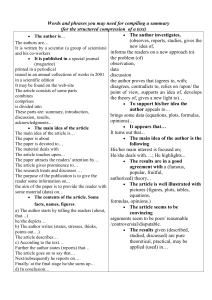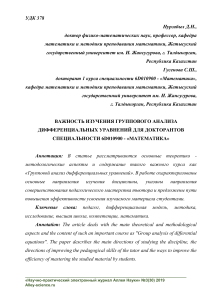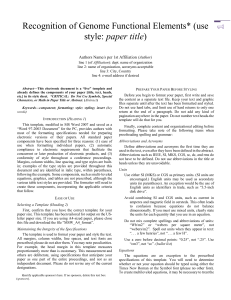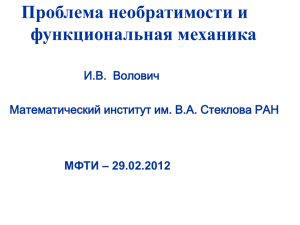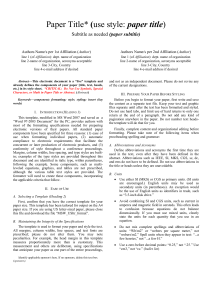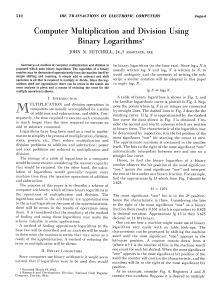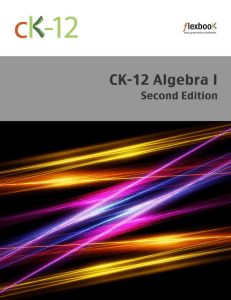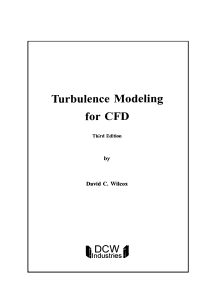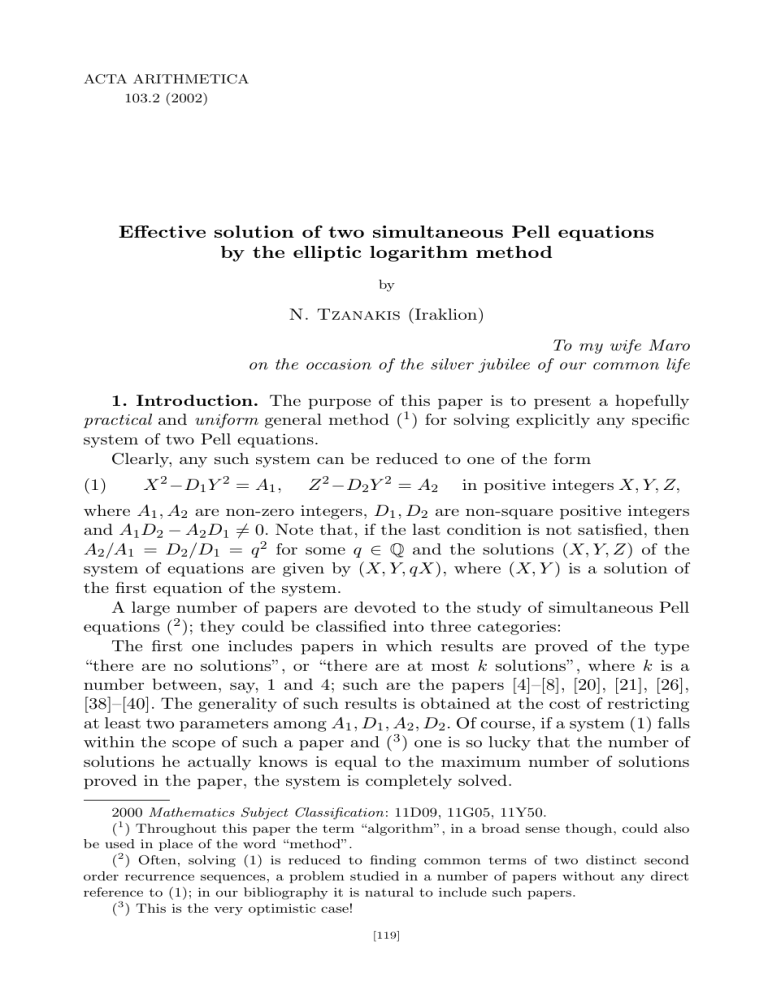
ACTA ARITHMETICA
103.2 (2002)
Effective solution of two simultaneous Pell equations
by the elliptic logarithm method
by
N. Tzanakis (Iraklion)
To my wife Maro
on the occasion of the silver jubilee of our common life
1. Introduction. The purpose of this paper is to present a hopefully
practical and uniform general method (1 ) for solving explicitly any specific
system of two Pell equations.
Clearly, any such system can be reduced to one of the form
(1)
X 2 −D1 Y 2 = A1 ,
Z 2 −D2 Y 2 = A2
in positive integers X, Y, Z,
where A1 , A2 are non-zero integers, D1 , D2 are non-square positive integers
and A1 D2 − A2 D1 6= 0. Note that, if the last condition is not satisfied, then
A2 /A1 = D2 /D1 = q 2 for some q ∈ Q and the solutions (X, Y, Z) of the
system of equations are given by (X, Y, qX), where (X, Y ) is a solution of
the first equation of the system.
A large number of papers are devoted to the study of simultaneous Pell
equations (2 ); they could be classified into three categories:
The first one includes papers in which results are proved of the type
“there are no solutions”, or “there are at most k solutions”, where k is a
number between, say, 1 and 4; such are the papers [4]–[8], [20], [21], [26],
[38]–[40]. The generality of such results is obtained at the cost of restricting
at least two parameters among A1 , D1 , A2 , D2 . Of course, if a system (1) falls
within the scope of such a paper and (3 ) one is so lucky that the number of
solutions he actually knows is equal to the maximum number of solutions
proved in the paper, the system is completely solved.
2000 Mathematics Subject Classification: 11D09, 11G05, 11Y50.
(1 ) Throughout this paper the term “algorithm”, in a broad sense though, could also
be used in place of the word “method”.
(2 ) Often, solving (1) is reduced to finding common terms of two distinct second
order recurrence sequences, a problem studied in a number of papers without any direct
reference to (1); in our bibliography it is natural to include such papers.
(3 ) This is the very optimistic case!
[119]
120
N. Tzanakis
In a second category we put papers dealing with the explicit solution of
some system(s), in which each parameter A1 , D1 , A2 , D2 has either a specific
numerical value or a certain special form. In these papers, either Baker’s
theory is applied or, quite often, elegant elementary arguments; see [2], [3],
[9], [13]–[16], [18], [24], [25], [28], [37].
A third category includes papers in which effective but not explicit results
are proved; see [19], [22], [23].
From the content and the results of the above papers it is clear that
their objects are distinct from that of the present paper (4 ). To the best of
the author’s knowledge, only two works in the literature deal with a similar
object (5 ):
First, W. S. Anglin’s book [1], Section 4.6, where a method is proposed
for solving (1) when all parameters are absolutely less than 1000. In principle, that method, which is based on the Theory of Linear Forms in Complex
Logarithms, can work in general, even without the above restriction on the
size of the parameters. Its complexity, however, depends upon the number
of prime factors of A1 and A2 , while the method proposed in the present
paper, based on the Theory of Linear Forms in Elliptic Logarithms, might
be free of this defect (6 ). Nice examples with a vivid discussion on the comparison of the Complex Logarithm versus the Elliptic Logarithm method are
found in [34].
Second, the paper [27] by R. G. E. Pinch, where the solution of (1) is
reduced to a finite number of problems of the form: “Given two distinct
second order recurrence sequences (Xk ) and (Yl ) assuming integer values
and an integer g, show that (0, 0) is the only pair (n, m) satisfying Xn =
Ym +g (∗)”. A first step of the method consists in obtaining an upper bound
B of n, using again the Theory of Linear Forms in Complex Logarithms.
Then an algorithm builds up, step by step, sets P and Q of primes with
certain properties. The main property of the set P is that its elements are
the prime factors of an integer N such that, if (∗) is satisfied, then n ≡ 0
(mod N ). One expects to build P so large that N > B, which will force
n = 0. It is not known a priori how large the primes in the sets P, Q
have to be (7 ); on the other hand, there is no theoretical guarantee that, in
any specific case, the method will work with sets P, Q including primes of
“reasonable” size.
(4 ) Cf. the very beginning of our Introduction.
(5 ) We do not include among them paper [24] in which an elementary interesting
method is proposed which, however, could not be considered “general”.
(6 ) I owe this remark to the referee.
(7 ) In [35], where we had to solve the system U 2 −5V 2 = −4µ, U 2 −10Z 2 = µ, µ = ±1,
we applied Pinch’s method; the sets P and Q turned out to include the 40 primes from 2
to 173 and the 145 primes from 3 to 997, respectively.
Simultaneous Pell equations
121
In the present paper, we adopt a quite different approach, using Elliptic Curves and Linear Forms of Elliptic Logarithms. The method that
we propose depends upon the theoretically non-effective computation of a
Mordell–Weil basis for a certain elliptic curve. This, in practice, causes no
real problems, given the current state of the art on the actual computation
of Mordell–Weil bases and the large positive experience from the extended
application of the elliptic curves techniques to the explicit solution of diophantine equations. A more serious problem from the application of the
method can possibly arise when the rank of the related elliptic curve is
high, say, larger than 7 or 8. In such a case (8 ), the final and theoretically
easiest step, which we describe after relation (21), may turn out a difficult
computational task.
Finally, we wish to stress the following fact: As the reader will realize,
for the application of our method we assume the knowledge of a non-trivial
rational solution (X0 , Y0 , Z0 ). What if we can neither detect such a solution
nor prove its non-existence by, say, congruence considerations? Note that
there are very efficient methods for deciding whether each equation in (1),
considered separately, has a rational solution; see, for example, [11] and the
references therein. Thus, if we know that both equations have rational solutions, but we are unable to decide whether the system of the two equations
has a rational solution (9 ), we can work, at least in principle, as follows: We
effectively obtain a rational
p solution (X0 , Y0 ), say, of the first equation, so
that (X0 , Y0 , Z0 ), Z0 = A2 + D2 Y02 is a solution belonging to at most a
quadratic extension K of Q and the method of this paper remains exactly
the same with K in place of Q. In practice, however, this implies working
with elliptic curves over K and the state of the art of this subject, from the
computational point of view, is not satisfactory today. Thus, although the
method developed in the present paper still works in this case, we cannot, at
present, be very optimistic about the happy outcome of the computations
related to the relevant elliptic curve.
Acknowledgements. I am grateful to my colleague J. Antoniadis and
the referee, who drew my attention to [1], an important reference which I
had missed out in the first version of the paper. I also thank Nils Bruin for
his very challenging electronic comments.
2. The method. We assume that a rational solution (X0 , Y0 , Z0 ) is
known with Y0 > 0 and X0 , Z0 ≥ 0, not both zero.
(8 ) Very unlikely to happen, we believe, if the parameters in (1) are not constructed
on purpose.
(9 ) It is worth asking whether such a case can occur in practice.
122
N. Tzanakis
2.1. The related elliptic curve and the birational transformation. Elimination of A1 , A2 from the two equations gives
A2 X 2 − A1 Z 2 + (A1 D2 − A2 D1 )Y 2 = 0.
(2)
We put
(3)
u=
Y0 X − X0 Y
,
Y0 Z − Z 0 Y
Y =
Y0 (X − uZ)
,
X0 − uZ0
so that
and substitute in (2) to obtain a quadratic equation in X/Z. Obviously,
X/Z = X0 /Z0 is one root of this quadratic equation, whence it follows that
the second root is
X
−A2 X0 u2 + 2A1 Z0 u − A1 X0
(4)
=
.
Z
A2 Z0 u2 − 2A2 X0 u + A1 Z0
Then, by the expression of Y in terms of X, Z and u, above, we obtain
Y
(−A2 u2 + A1 )Y0
=
.
Z
−A2 Z0 u2 + 2A2 X0 u − A1 Z0
(5)
We have 1 − D2 (Y /Z)2 = A2 /Z 2 , hence, by (5) and the relations
(6)
it follows that
(7)
where
(8)
v=σ
X02 − D1 Y02 = A1 ,
Z02 − D2 Y02 = A2 ,
au4 + bu3 + cu2 + du + e2 = v 2 ,
−A2 Z0 u2 + 2A2 X0 u − A1 Z0
,
Z
σ = sgn(A1 ),
and
(9)
a = A22 ,
b = −4A2 X0 Z0 ,
c = 4A1 Z02 − 2A1 A2 + 4A2 X02 ,
d = −4A1 X0 Z0 ,
e = |A1 |.
Later we will justify the choice of σ in (8). Using (3) in (8) and taking into
account (6) we express v as a rational function of X, Y, Z:
(10)
v = 2σY02
A2 X0 X + (D2 A1 − D1 A2 )Y0 Y − A1 Z0 Z
.
(Y0 Z − Z0 Y )2
Conversely, we need also express X, Y, Z as rational functions of u, v. By the
definition of v,
−A2 Z0 u2 + 2A2 X0 u − A1 Z0
(11)
Z=σ
v
Simultaneous Pell equations
123
and this, combined with (5), (4) and (6) gives
(−A2 u2 + A1 )Y0
A2 X0 u2 − 2A1 Z0 u + A1 X0
, X=σ
.
v
v
We consider now (7). Following Section 2 of [36], we define the rational
functions
c
2ev + du + 2e2
(13)
x(u, v) =
+ ,
u2
3
8e3 v + 8e4 + 4e2 du + (4e2 c − d2 )u2
(14)
σ · y(u, v) =
2eu3
d
cd
+
x(u, v) −
+ be,
2e
6e
12e2 x + 8e2 c − 3d2
(15)
,
u(x, y) =
2(6σye − 3dx + cd − 6be2 )
3x − c
d
v(x, y) =
(16)
u(x, y)2 − u(x, y) − e,
6e
2e
where, as before, σ = sgn(A1 ). The functions
(12) Y = σ
(u, v) 7→ (x, y) = (x(u, v), y(u, v)),
(x, y) 7→ (u, v) = (u(x, y), v(x, y))
(17)
(18)
establish a birational transformation between (7) and
y 2 = x3 + Ax + B,
(19)
where
A = − 31 c2 + bd − 4ae2 ,
B=
2 3
27 c
− 31 bcd − 83 ace2 + b2 e2 + ad2 .
So far, our discussion sums up to the following:
Proposition 2.1. Let (X, Y, Z) be a solution of the initial system (1).
Using (3) and (10) we obtain (u, v) satisfying (7) and then, by (17), we
obtain (x, y) satisfying (19). This gives a birational transformation from (1)
to (19), say x = X (X, Y, Z), y = Y(X, Y, Z). Conversely, if (x, y) satisfies
(19), then, using (18), we obtain (u, v) satisfying (7) and then, by (11) and
(12), we obtain a solution (X, Y, Z) of (1).
2.2. Some technical results. The following result is useful for the practical application of our method.
Proposition 2.2. The right-hand side of (19) has three distinct rational roots, namely
%1 = 34 (D2 X02 − 2D1 D2 Y02 + D1 Z02 )Y02 = 34 (A1 D2 + A2 D1 )Y02 ,
%2 = 34 (−2D2 X02 + D1 D2 Y02 + D1 Z02 )Y02 = 43 (A2 D1 − 2A1 D2 )Y02 ,
%3 = 34 (D2 X02 + D1 D2 Y02 − 2D1 Z02 )Y02 = 34 (A1 D2 − 2A2 D1 )Y02 ,
124
N. Tzanakis
hence, the curve E defined by (19) is an elliptic curve. Denote by e1 , e2 , e3 ,
respectively, the largest, middle and least among the three roots above. Then
the following table gives the values of e1 , e2 , e3 :
A1
A2
A2 D 1 − A 1 D 2
e3
e2
e1
>0
>0
>0
<0
<0
<0
>0
>0
<0
>0
<0
<0
>0
<0
any sign
any sign
>0
<0
%3
%2
%2
%3
%1
%1
%2
%3
%1
%1
%3
%2
%1
%1
%3
%2
%2
%3
Moreover , define
p
p
x0 = lim X ( A1 + D1 Y 2 , Y, − A2 + D2 Y 2 ),
Y →+∞
p
p
y0 = lim Y( A1 + D1 Y 2 , Y, − A2 + D2 Y 2 ).
Y →+∞
√
√
Then x0 , y0 ∈ Q( D1 , D2 ), x0 > e1 , y0 > 0 and (x0 , y0 ) is a point on E0 ,
the zero-component of the elliptic curve E.
Finally, for any positive solution (X, Y, Z) of (1), with Y sufficiently
large, the point (x, y) = (X (X, Y, −Z), Y(X, Y, −Z)) belongs to E0 and y > 0;
how large Y must be, can be made explicit in any particular case (1).
Proof. With Maple V we easily calculated the three roots. These are
distinct, in view of our initial restrictions on the parameters of (1). Every
claim in the table can be checked without much difficulty, but this is probably a rather tedious task without the aid of a Computer Algebra package.
The same is true for the computation of x0 and y0 , the values of which are
p
4Y 2
x0 = 0 (D2 X02 + D1 D2 Y02 + D1 Z02 + 3 D1 D2 X0 Y0
3
p
p
+ 3D1 D2 Y0 Z0 + 3 D1 D2 X0 Z0 ),
√
√
√
√
8σ|A1 |Y03 D1 (Z0 D1 + X0 D2 )(Z0 + Y0 D2 )
√
y0 =
.
X0 − Y0 D1
It is now clear that x0 is positive
√ and larger than all three roots %1 , %2 , %3 .
On the other hand, sgn(X0 − Y0 D1 ) = sgn(A1 ) = σ, hence
p y0 > 0. Finally,
A1 + D1 Y 2 , Z =
if
(X,
Y,
Z)
is
a
positive
solution
of
(1),
then
X
=
p
2
A2 + D2 Y , hence, for sufficiently large Y , the number X (X, Y, −Z) is
sufficiently close to x0 , which in turn is larger than e1 ; this, obviously, proves
that (x, y) ∈ E0 and y > 0 in view of the fact that, for sufficiently large Y ,
y is near y0 .
Simultaneous Pell equations
125
We also need the following
p
p
Lemma 2.3. The substitution ( A1 + D1 Y 2 , − A2 + D2 Y 2 ) ← (X, Z)
in (10) results in a function v = v(Y ), which, for sufficiently large Y , assumes positive values.
Proof. In (10), the factor that determines the sign of v is (after the
substitution mentioned in the lemma)
p
p
σ(A1 Z0 A2 + D2 Y 2 + (D2 A1 − D1 A2 )Y0 Y + A2 X0 A1 + D1 Y 2 ).
Dividing this by Y and letting Y → +∞, we find the limit
p
p
p
p
σ(X0 − Y0 D1 )(Z0 D1 + X0 D2 )(Z0 + Y0 D2 ),
which is positive, as we saw in the proof of Proposition 2.2. This, certainly,
implies that, for sufficiently large Y , the corresponding v is positive.
The following result is implicitly needed for our method.
Lemma 2.4. There exists a positive constant Ψ0 , explicitly computable in
every particular instance of the system (1), such that the bijection
p
p
[Ψ0 , +∞) 3 Y → X ( A1 + D1 Y 2 , Y, − A2 + D2 Y 2 )
p
p
∈ [X ( A1 + D1 Ψ02 , Ψ0 , − A2 + D2 Ψ02 ), x0 )
is strictly decreasing.
Proof. The proof is elementary, but quite
p we turned
p tedious; once again
to the aid of Maple V. The function X ( A1 + D1 Y 2 , Y, − A2 + D2 Y 2 )
is the composition h2 ◦ h1 of the functions
p
X 0 Y − Y 0 A1 + D 1 Y 2
h1 : Y 7→ u = p
(cf. (3)),
Y0 A2 + D2 Y 2 + Z0 Y
p
h2 : u 7→ x(u, au4 + bu3 + cu2 + du + e2 )
(cf. (13) and (10)),
with a, b, c, d, e as defined in (9). A small explanation on the definition of h2 :
The arguments of the function x in (13) arepu = h1 (Y ) and p
the v obtained
from (10) after the substitution (X, Z) ← ( A1 + D1 Y 2 , − A2 + D2 Y 2 ).
By Lemma 2.3, this value√of v is positive, for sufficiently large Y , hence,
by (7), it is expressed as au4 + bu3 + cu2 + du + e2 (10 ). A computation
shows that (primed letters denote derivatives)
√
√
√
Y0 (X0 − Y0 D1 )(Z0 D1 + X0 D2 )
0
√
√
.
lim h1 (Y ) =
Y →+∞
D1 D2 (Z0 + Y0 D2 )
√
Since sgn(X0 −Y0 D1 ) = sgn(A1 ) = σ, this shows that, for sufficiently large
Y , the function h1 is strictly increasing if σ = +1 and strictly decreasing if
(10 ) We always use the symbol
√
to denote the positive square root.
126
N. Tzanakis
σ = −1. We also note that
√
X0 − Y0 D1
√
lim h1 (Y ) =
=: u0 .
Y →+∞
Z0 + Y0 D2
Next, we consider
the function h2 (u) for u sufficiently near to u0 . We
p
write h2 (u) = 2e h3 (u) + h4 (u), where
h3 (u) = a +
c
d
e2
b
+ 2 + 3 + 4,
u u
u
u
h4 (u) =
d 2e2
c
+ 2 + .
u
u
3
We compute
p
p
4Y0
(X0 + Y0 D1 D2 + Z0 D1 )
A1
p
p
× (X0 + Y0 D1 )2 (Z0 + Y0 D2 )2 ,
p
p
p
8Y 3
h04 (u0 ) = − 30 (Z0 D1 + X0 D2 )(X0 + Y0 D1 )3
A1
p
p
× (Z0 + Y0 D2 )3 D1 D2 .
h03 (u0 ) = −
Thus, sgn(h03 (u0 )) = sgn(h04 (u0 )) = −σ, which shows that, near u0 , h2 (u) is
strictly decreasing if σ = +1 and strictly increasing if σ = −1. If we combine
with the analogous conclusion for h1 (u), we see that, for sufficiently large
Y , the function h2 ◦ h1 (Y ) is strictly decreasing, as claimed.
2.3. Elliptic integrals and linear forms in elliptic logarithms. Differentiating (3) and taking into account that XdX = D1 dY and ZdX = D2 dY
we get
du = −
Y0 (−A2 D1 Y0 Y + A2 X0 X + A1 D2 Y0 Y − A1 Z0 Z)
dY.
XZ(Y0 Z − Z0 Y )2
Then, taking into account (10) and the relation
dx
du
= −σ
y
v
(see e.g. relation (2) of [33] (11 )), we conclude that
(20)
dx
1
dY
=
·
.
y
2Y0 XZ
From now on we will assume that (X, Y, Z) is a positive integer solution
of (1) with Y sufficiently large (cf. Proposition 2.2 and Lemmas 2.3 and
2.4) and we will consider P = (x(P ), y(P )) = (X (X, Y, −Z), Y(X, Y, −Z)),
which, by Proposition 2.2, belongs to E0 (Q) and has y(P ) > 0. If necessary,
we may also write X(P ), Y (P ), Z(P ) instead of X, Y, −Z. Conversely, by
(11 ) In the notation of that paper, f (u, v) = au4 + bu3 + cu2 + du + e2 − v 2 and a
(symbolic) computation shows that G(u, v) = −σ.
Simultaneous Pell equations
127
Proposition 2.1, any point P ∈ E(Q) (12 ) corresponds to a rational solution
(X(P ), Y (P ), Z(P )) of (1).
Assume now that we know a basis P1 , . . . , Pr for the torsion-free part of
the Mordell–Weil group E(Q) (13 ). Observe that, for any Pi , if Pi 6∈ E0 (Q),
then Pi + (e2 , 0) ∈ E0 (Q). Therefore,
We can always choose the points of our basis so that P1 , . . . , Pr belong
to E0 (Q).
We put
(21)
P = m1 P1 + . . . + mr Pr + T,
where T denotes a torsion point which, necessarily, belongs to E0 (Q) and
the mi ’s are unknown integers. If we manage to bound
M = max{|m1 |, . . . , |mr |},
then we can effectively solve, at least in principle, our system (1). Indeed, for
any (m1 , . . . , mr ) satisfying this bound and any torsion point T ∈ E0 (Q), we
compute the point P = (x(P ), y(P )) and then, by the procedure described
in Proposition 2.1, we obtain a rational solution (X(P ), Y (P ), Z(P )), which
we accept if and only if all three X(P ), Y (P ), Z(P ) are integers.
A basic tool for our method is the usual isomorphism
φ : E0 (R) → [0, 1) = R/Z
√
+∞
(see e.g. Section 2 of [31]). Let also ω = 2 e1 dx/ x3 + Ax + B, the fundamental real period. From (21) we see that
(22)
φ(P ) = m1 φ(P1 ) + . . . + mr φ(Pr ) + m0 + s/t,
where m0 ∈ Z and s/t = φ(T ) with 0 < s < t relatively prime integers,
effectively bounded by a small number (see e.g. Section 4 of [31]). Moreover,
since the φ-values are positive and < 1, it follows that
(23)
|m0 | ≤ rM.
We now exhibit the close relation of φ(P ) with an elliptic integral dx
y ,
√
3
where
x + Ax + B. We will need the point Q0 = (x0 , y0 ) ∈
√ y √=
E0 ( D1 , D2 ), with x0 , y0 as defined in Proposition 2.2. We have
x0
x(P )
dx
=
y
+∞
x(P )
dx
−
y
+∞
x0
dx
= ωφ(P ) − ωφ(Q0 ),
y
by the definition of φ. This, combined with (22) shows that the integral on
the left-hand side of the above relation is equal to a linear form in elliptic
(12 ) Actually, we deal only with points P ∈ E0 (Q).
(13 ) This is, of course, the non-effective part of the method of this paper.
128
N. Tzanakis
logarithms:
x0
x(P )
s
dx
= L(P ) := −ωφ(Q0 ) + m0 +
ω + m1 ωφ(P1 ) + . . . + mr ωφ(Pr ).
y
t
A symbolic computation using Maple V shows that
2 · Q0 =
2
4
3 (D2 X0
+ D1 D2 Y02 + D1 Z02 )Y02 , 8D1 D2 X0 Y04 Z0 .
Therefore, 2 · Q0 ∈ E0 (Q), hence 2 · Q0 = k1 P1 + . . . + kr Pr + T 0 , where
k1 , . . . , kr are explicitly known rational integers and T 0 ∈ E0 (Q) is a torsion
point. Then
k1
kr
k0
s0
φ(P1 ) + . . . +
φ(Pr ) +
+ 0,
2
2
2
2t
0
0
where k0 is an explicitly known integer and s , t have analogous properties
to those of s, t (see immediately after (22)). This transforms the expression
of the linear form L(P ) into
φ(Q0 ) =
x0
(24)
x(P )
dx
p0
p1
pr
= L(P ) =
ω+
ωφ(P1 ) + . . . + ωφ(Pr ),
y
q0
2
2
where p0 , p1 , . . . , pr are rational (unknown) integers and q0 is an explicitly
known “small” integer (14 ). Moreover, it is clear that (15 ),
(25)
N := max |pi | ≤ αM + β,
0≤i≤r
where the “small” positive constants α, β can be explicitly calculated in
every specific case.
2.4. Estimating the linear form in elliptic logarithms. The following
steps lead now to an upper bound for |L(P )| in terms of M .
• By (20) and Lemma 2.4 we conclude (16 )
x0
(26)
x(P )
dx
1
=−
y
2Y0
+∞
dY
p
,
2 )(A + D Y 2 )
(A
+
D
Y
1
1
2
2
Y (P )
therefore, for sufficiently large Y (17 ), (24) and (26) imply that
(27)
|L(P )| ≤ c1 Y −1 ,
where c1 is an explicit positive constant.
(14 )
(15 )
(16 )
(17 )
Actually, p0 /q0 = m0 − k0 /2 + s/t − s0 /(2t0 ) and pi = mi − ki /2 for i = 1, . . . , r.
We use also (23) at this point.
√
√
We always have in mind that X = A1 + D1 Y 2 and Z = − A2 + D2 Y 2 .
This is easily made explicit.
Simultaneous Pell equations
129
• x(P ) is an explicit rational function X (X, Y, Z), hence, for the height
h(x(P )), wepcan find an explicit upper
bound in terms of X, Y, Z (18 ). Then,
p
since X = A1 + D1 Y 2 , Z = − A2 + D2 Y 2 , it follows that
(28)
h(x(P )) ≤ c2 + 2 log Y,
where c2 is an explicit positive constant.
• We have an inequality of the form
(29)
b
h(P ) − 21 h(x(P )) ≤ c3 ,
where b
h(·) denotes the canonical height, as defined, for example, in Silverman’s book [29], and c3 is an explicit positive constant; see e.g. [30].
• We refer to (21). It is a well known fact that b
h(P ) is a positive-definite
quadratic form q(m1 , . . . , mr ), hence
(30)
b
h(P ) ≥ λM 2 ,
where λ is the least eigenvalue of the matrix of the quadratic form q, hence
an explicit positive constant.
• An obvious combination of (27)–(30) gives
(31)
|L(P )| ≤ c1 exp(0.5c2 + c3 − λM 2 ).
Next, an explicit lower bound for |L(P )| in terms of N is obtained by
a deep theorem due to S. David [12]. A version of this theorem adapted to
our needs is found in the Appendix of [36]. According to Theorem 5 of that
Appendix, either N is “very small”, or
|L(P )| ≥ exp(−c4 (log N + c5 )(log log N + c6 )r+2 ),
where c4 , c5 , c6 are explicit positive constants. Taking into account (25), we
write the last relation as
(32) |L(P )| ≥ exp(−c4 (log(αM + β) + c5 )(log log(αM + β) + c6 )r+2 ).
Since the lower bound in (32) is larger than the upper bound in (31) if M
is sufficiently large, it follows that M must be bounded by some explicit
upper bound. The upper bound for M which is obtained in this way is
huge. The rather large experimental experience accumulated so far shows
2
that this bound is of the size of 10(5r +15r+28)/2 ; see Section 3 of [32]. This
bound is dramatically reduced with the use of the LLL Basis Reduction
Algorithm. The reduction process has been extensively discussed in many
relevant papers, so that there is no point to discuss it here once again; we
refer the reader to Section 5 of [31], Section 5 of [36] and Section 6 of [17] (19 ).
(18 ) The fact that X, Y, Z are integers is a crucial “detail” here.
(19 ) These are just three indicative references.
130
N. Tzanakis
3. Examples. In the examples of this section, all computations related
to elliptic curves have been done by Apecs of Ian Connell, a package based
on Maple V. In all cases, the Mordell–Weil bases were computed unconditionally (no conjectures were assumed) and care was taken to transform the
points of the basis to ones belonging to the zero-component of the curve, by
adding the point (e2 , 0) if necessary (cf. just before (21)).
Also, the results of Subsection 2.2 require that Y be “sufficiently large”.
In every example, computations, very simple in practice, show that Y ≥ 10
is more than enough.
3.1. The system with D1 = 5, A1 = 19, D2 = 3, A2 = −11. A rational
solution: (X0 , Y0 , Z0 ) = (8, 3, 4). The corresponding Weierstrass model is
y 2 = x3 − 4064688x + 97538688.
(33)
The roots of the right-hand side are
e3 = −2028,
e2 = 24,
e1 = 2004.
Relations (3) and (10) now become
u=
3X − 8Y
,
3Z − 4Y
v = −72
hence, by (13) and (17),
x=
22X − 84Y + 19Z
,
(3Z − 4Y )2
−12
(7477Y 2 − 19152Y − 4008XY − 3420YZ
(3X − 8Y )2
+ 1824ZX + 5016X + 4332Z + 11571),
from which we find
√
√ √
√
x0 = 4884 + 2160 3 + 2592 5 + 1152 5 3 ≈ 18882.7947568591741,
and by (14) and (17),
y=
16416
(855Y 3 + 7477Y 2 − 456XY 2 − 2140ZY 2 − 4008XY − 9519Y
(3X − 8Y )3
+ 1002XZY + 456ZY + 190XZ + 3344X − 1900Z + 17347).
Also, relations (11) and (12) give
11u2 + 19u − 19
11u2 + 19
44u2 − 176u − 76
, Y =3
, Z=
,
v
v
v
from which, by means of (15), (16) and (18), we obtain
X = −8
x3 + 828x2 + 90yx + 15841008x − 20126660544 + 182520y
,
x3 − 14652x2 + 4064688x + 19656858816 − 622080y
x3 + 4932x2 + 128yx − 12427344x + 20041387200 − 3072y
Y =3
,
x3 − 14652x2 + 4064688x + 19656858816 − 622080y
X=8
Simultaneous Pell equations
131
x3 + 8892x2 + 216yx − 23737104x − 19181430720 − 432864y
.
x3 − 14652x2 + 4064688x + 19656858816 − 622080y
A basis for the torsion-free part of E(Q), where E is the elliptic curve defined
by (33), is
P1 = (7548, 632016), P2 = (112884, 37920960)
Z = −4
(P1 , P2 ∈ E0 (Q)) and T = (2004, 0) is the only torsion point on E0 (Q). With
the aid of the function Expr of Apecs we find that
2 · Q0 = (4884, 311040) = P1 + P2 .
We easily check that φ(2 · Q0 ) = φ(P1 ) + φ(P2 ) and φ(T ) = 1/2. Therefore,
if P is a point on the elliptic curve which corresponds to an integer solution
of our system of Pell equations and we put
P = m1 P1 + m2 P2 + T,
M = max{|m1 |, |m2 |},
then the corresponding linear form in elliptic logarithms is
p1
p2
p0
ω+
ωφ(P1 ) +
ωφ(P2 ),
L(P ) =
2
2
2
where pi = 2mi − 1 (i = 1, 2) and p0 = 2m0 + s for some integers m0 with
|m0 | ≤ 2M and s ∈ {0, 1} (cf. (23)). Therefore, in the notation of (25),
α = 4, β = 1. Also, A1 + D1 Y 2 = 19 + 5Y 2 > 5Y 2 and A2 + D2 Y 2 =
−11 + 3Y 2 > 2.9725Y 2 , provided that Y > 20. Therefore, in (27) we can
take c1 = 0.04324. In the expression
√ of x as a rational
√ function of X, Y, Z
we make the substitution X = 19 + 5Y 2 , Z = − −11 + 3Y 2 ; then it
is straightforward to check that the maximum of the absolute values of the
numerator and denominator is ≤ 376400Y 2 , provided that Y > 20; therefore
in (28) we can take c2 = log 376400. In (29) we use Silverman’s result [30],
which gives c3 = 5.84226214. An easy program based on Maple V and
Apecs calculates the least eigenvalue of the positive-definite matrix related
to b
h, giving thus λ = 0.5179388. Following the detailed steps described in
the Appendix of [36] we calculate
c4 = 4.046622 · 1074 ,
c5 = 2.570121,
c6 = 30.018387
and the comparison of the upper bound (31) with the lower bound (32) forces
M ≤ 3.41 · 1041 . Following the reduction technique that uses the LLL basis
reduction algorithm (as implemented in Pari), we can immediately reduce
this huge upper bound down to 20 and then, by a second reduction step we
reduce the bound to 7. Finally, by a simple program that uses Maple and
Apecs we compute all combinations
(x, y) = m1 P1 + m2 P2 + εT,
−7 ≤ mi ≤ 7 (i = 1, 2), ε = 0, 1
and for each we insert the values of x and y in the previously obtained formulas, which express X, Y, Z as rational functions of x, y. The only positive
integer triads (X, Y, Z) obtained in this way are (8, 3, 4) and (12, 5, 8). Since
132
N. Tzanakis
the computation of certain ci ’s has been done under the assumption Y > 20,
we
√ also check which
√ integer values in the range 1 ≤ Y ≤ 20 are such that
19 + 5Y 2 and −11 + 3Y 2 are both integers. No values of Y besides 3
and 5 satisfy this condition, from which we conclude that the only positive
integer solutions (X, Y, Z) to the system (1) in this specific case are those
two mentioned above.
3.2. The system with D1 = 7, A1 = 2, D2 = 32, A2 = −23. This example is partially
is proved that, if (X, Y, Z) is a solution,
√ [10], where
√ it 192
√ solved in
then X +Y 7 < (3+ 7)(8+3 7)17 . Here we give the complete solution.
A rational solution: (X0 , Y0 , Z0 ) = (3, 1, 3). The corresponding Weierstrass
model is
645136
692527232
y 2 = x3 −
(34)
x−
3
27
with right-hand side having roots
388
1544
1156
, e2 = −
,
e1 =
.
e3 = −
3
3
3
Relations (3), (10) and (17) combined with (13) and (14), respectively, give
8(−235 − 207X + 675Y − 18Z + 579XY + 63YZ − 27ZX − 1448Y 2 )
,
3(X − 3Y )2
−96
y=
(−224Y 3 + 96XY 2 − 1448Y 2 + 504ZY 2 + 579XY − 54ZY
(X − 3Y )3
+ 386Y − 193XZY − 138X + 63Z − 253 + 14XZ),
x=
from the first of which we find
√
√
√ √
2300
x0 =
+ 384 7 + 336 2 + 144 7 2 ≈ 2796.609591.
3
Relations (11) and (12) combined with (15), (16) and (18), respectively, give
27x3 − 108x2 + 756yx + 6552144x + 291312y − 3080761664
,
27x3 − 62100x2 + 5806224x − 870912y + 5836492864
27x3 + 13716x2 − 11161008x + 972yx + 125712y + 2373881536
Y =
,
27x3 − 62100x2 + 5806224x − 870912y + 5836492864
27x3 + 48492x2 + 3456yx − 24422256x − 7899721664 − 1778688y
.
Z = −3
27x3 − 62100x2 + 5806224x − 870912y + 5836492864
A basis for the torsion-free part of E(Q), where E is the elliptic curve
defined by (34), consists of the single point P1 = (8444/3, 147200), and
T = (1544/3, 0) is the only torsion point on E0 (Q). With the aid of the function Expr of Apecs we find that 2 · Q0 = (2300/3, 16128) = −P1 + T and
we easily check that φ(Q0 ) = 41 − 12 φ(P1 ) and φ(T ) = 1/2. If P is a point
on the elliptic curve, which corresponds to an integer solution of our system
of Pell equations and we put P = m1 P1 , M = |m1 |, then the corresponding
linear form in elliptic logarithms is
X=3
Simultaneous Pell equations
133
p0
p1
ω+
ωφ(P1 ),
2
2
where p1 = 2m1 + 1 and p0 = 4m0 + 2s − 1 for some integers m0 with
|m0 | ≤ M and s ∈ {0, 1} (cf. (23)). Therefore, in the notation of (25),
α = 4, β = 1.
Calculations completely analogous to those in Example 3.1 give c1 =
0.03344, c2 = 9.67, c3 = 5.1074513, λ = 0.69249, c4 = 6.251·1044 , c5 = 2.752,
c6 = 34.56585 and the comparison of the upper bound (31) and the lower
bound (32) forces M ≤ 5.8 · 1025 . The reduction process gives the bound
M ≤ 20. We compute all combinations
L(P ) =
(x, y) = m1 P1 + εT,
−20 ≤ m1 ≤ 20, ε = 0, 1,
and for each we insert the values of x and y in the above expressions of
X, Y, Z as rational functions of x, y. The only positive integer triads (X, Y, Z)
obtained in this way are (3, 1, 3) and (717, 271, 1533). Since the computation
of certain ci ’s have been done under the assumption Y > 20, we also check
whether there are solutions (X, Y, Z) with 1 < Y ≤ 20, but this reveals no
further solution. Therefore, the only positive integer solutions (X, Y, Z) to
the system (1) in this specific case are those two mentioned above.
3.3. Three examples taken from the literature. In this section we discuss,
in brief, the application of our method to the solution of three examples
taken from the literature.
The first is the well known example of A. Baker and H. Davenport [3].
Solutions are also given in [18] and [28]. In the notation of the present
paper, D1 = 3, A1 = −2, D2 = 8, A2 = −7 and (X0 , Y0 , Z0 ) = (1, 1, 1). The
parameters in the Weierstrass model (19) are A = −5776/3, B = 677248/27.
The rank of the curve is 1, P1 = (524/3, 2240) being a basic point. Then the
resolution of the system is completely analogous to that of Subsection 3.2
and proves that the only solutions in positive integers (X, Y, Z) are (1, 1, 1)
and (19, 11, 31).
A second example comes from the system z 2 − 3y 2 = −2, z 2 − 6x2 = −5,
studied in [37]. The substitution (3y, z, 6x) = (X, Y, Z) gives a system (1)
with D1 = 3, A1 = 6, D2 = 6, A2 = 30 and (X0 , Y0 , Z0 ) = (3, 1, 6). The
parameters in the related Weierstrass elliptic curve (19) are A = −32832,
B = 774144. The rank of the curve is 1, P1 = (888, 25920) being a basic
point. As in the previous example, the resolution of the system is completely
analogous to that of Subsection 3.2 and proves that the only solutions in
positive integers (X, Y, Z) are (3, 1, 6) and (123, 71, 174), hence the only
positive integer solutions (x, y, z) are (1, 1, 1) and (29, 41, 71).
The third example is found in [25] and corresponds to D1 = 5, A1 =
−20, D2 = 2, A2 = 1 and (X0 , Y0 , Z0 ) = (0, 2, 3). The parameters in the
related elliptic curve (19) are A = −467200/3, B = −609280000/27 and the
134
N. Tzanakis
rank of the curve is zero. The only rational point on the zero-component
of the curve is the torsion point T = (1360/3, 0) and the correspondence
(x, y) → (X, Y, Z) gives no further solution.
References
[1]
[2]
[3]
[4]
[5]
[6]
[7]
[8]
[9]
[10]
[11]
[12]
[13]
[14]
[15]
[16]
[17]
[18]
[19]
[20]
[21]
W. S. Anglin, The Queen of Mathematics—An Introduction to Number Theory,
Kluwer, Dordrecht, 1995.
—, Simultaneous Pell equations, Math. Comp. 65 (1996), 355–359.
A. Baker and H. Davenport, The equations 3x2 − 2 = y 2 and 8x2 − 7 = z 2 , Quart.
J. Math. Oxford Ser. (2) 20 (1969), 129–137.
M. A. Bennett, Solving families of simultaneous Pell equations, J. Number Theory
67 (1997), 246–251.
—, On the number of solutions to simultaneous Pell equations, J. Reine Angew.
Math. 498 (1998), 173–199.
—, On consecutive integers of the form ax2 , by 2 and cz 2 , Acta Arith. 88 (1999),
363–370.
M. A. Bennett and P. G. Walsh, Simultaneous quadratic equations with few or no
solutions, Indag. Math. (N.S.) 11 (2000), 1–12.
J. H. Chen, Common solutions of the Pell equations x2 − 2y 2 = 1 and y 2 − Dz 2 = 4,
J. Wuhan Univ. Natur. Sci. Ed. 1990, no. 1, 8–12 (in Chinese).
Z. Y. Chen, The diophantine system of equations 5x2 − 3y 2 = 2, 16y 2 − 5z 2 = 11,
J. Central China Normal Univ. Natur. Sci. 30 (1996), 381–384 (in Chinese).
—, Upper bounds for positive integer solutions of the indeterminate equations x 2 −
7y 2 = 2, z 2 − 32y 2 = −23, ibid. 31 (1997), 253–256 (in Chinese).
J. E. Cremona and D. Rusin, Efficient solution of rational conics, Math. Comp., to
appear.
S. David, Minorations de formes linéaires de logarithmes elliptiques, Mém. Soc.
Math. France (N.S.) 62 (1995).
A. Dujella, An absolute bound for the size of Diophantine m-tuples, J. Number
Theory 89 (2001), 126–150.
—, Complete solution of a family of simultaneous Pellian equations, Acta Math.
Inform. Univ. Ostraviensis 6 (1998), 59–67.
A. Dujella and B. Jadrijević, A parametric family of quartic Thue equations, Acta
Arith. 101 (2002), 159–170.
A. Dujella and A. Pethő, A generalization of a theorem of Baker and Davenport,
Quart. J. Math. Oxford Ser. (2) 49 (1998), 291–306.
J. Gebel, A. Pethő and H. G. Zimmer, Computing integral points on elliptic curves,
Acta Arith. 68 (1994), 171–192.
P. Kanagasabapathy and T. Ponnudurai, The simultaneous diophantine equations
y 2 − 3x2 = −2 and z 2 − 8x2 = −7, Quart. J. Math. Oxford Ser. (2) 26 (1975),
275–278.
P. Kiss, On common terms of linear recurrences, Acta Math. Acad. Sci. Hungar. 40
(1982), 119–123.
W. Ljunggren, A note on simultaneous Pell equations, Norsk. Mat. Tidsskr. 23
(1941), 132–138 (in Norwegian).
D. W. Masser and J. H. Rickert, Simultaneous Pell equations, J. Number Theory
61 (1996), 52–66.
Simultaneous Pell equations
[22]
[23]
[24]
[25]
[26]
[27]
[28]
[29]
[30]
[31]
[32]
[33]
[34]
[35]
[36]
[37]
[38]
[39]
[40]
135
M. Mignotte, Intersection des images de certaines suites récurrentes linéaires, Theoret. Comput. Sci. 7 (1978), 117–122.
—, Une extension du théorème de Skolem–Mahler , C. R. Acad. Sci. Paris Sér. A
288 (1979), 233–235.
S. P. Mohanty and A. M. S. Ramasamy, The characteristic number of two simultaneous Pell’s equations and its applications, Simon Stevin 59 (1985), 203–214.
—, —, The simultaneous diophantine equations 5y 2 − 20 = X 2 and 2y 2 + 1 = Z 2 ,
J. Number Theory 18 (1984), 356–359.
J. Pan, Y. Zhang and R. Zou, The Pell equations x2 − 8y 2 = 1 and y 2 − Dz 2 = 1,
Chinese Quart. J. Math. 14 (1999), 73–77.
R. G. E. Pinch, Simultaneous Pellian equations, Math. Proc. Cambridge Philos.
Soc. 103 (1988), 35–46.
G. Sansone, Il sistema diofanteo N + 1 = x2 , 3N + 1 = y 2 , 8N + 1 = z 2 , Ann. Mat.
Pura Appl. 111 (1976), 125–151.
J. H. Silverman, The Arithmetic of Elliptic Curves, Grad. Texts in Math. 106,
Springer, Berlin, 1986.
—, The difference between the Weil height and the canonical height on elliptic
curves, Math. Comp. 55 (1990), 723–743.
R. J. Stroeker and N. Tzanakis, Solving elliptic diophantine equations by estimating
linear forms in elliptic logarithms, Acta Arith. 67 (1994), 177–196.
—, —, On the elliptic logarithm method for elliptic diophantine equations: Reflections and an improvement, Experiment. Math. 8 (1999), 135–149.
—, —, Computing all integer solutions of a general elliptic equation, in: W. Bosma
(ed.), ANTS-IV, Lecture Notes in Comput. Sci. 1838, Springer, Berlin, 2000,
551–561.
R. J. Stroeker and B. M. M. de Weger, On elliptic diophantine equations that defy
Thue—The case of the Ochoa curve, Experiment. Math. 3 (1994), 1–12.
N. Tzanakis, Explicit solution of a class of quartic Thue equations, Acta Arith. 64
(1993), 271–283.
—, Solving elliptic diophantine equations by estimating linear forms in elliptic logarithms. The case of quartic equations, ibid. 75 (1996), 165–190.
M. Veluppillai, The equations z 2 − 3y 2 = −2 and z 2 − 6x2 = −5, in: A Collection
of Manuscripts Related to the Fibonacci Sequence, Fibonacci Assoc., Santa Clara,
CA, 1980, 71–75.
P. G. Walsh, On integer solutions to x2 − dy 2 = 1, z 2 − 2dy 2 = 1, Acta Arith. 82
(1997), 69–76.
—, On two classes of simultaneous Pell equations with no solutions, Math. Comp.
68 (1999), 385–388.
D. G. Zeng, More on simultaneous solutions of the Pell equations x 2 − 2y 2 = 1 and
y 2 − Dz 2 = 4, Math. Practice Theory 1995, no. 1, 81–83 (in Chinese).
Department of Mathematics
University of Crete
Iraklion, Greece
E-mail: [email protected]
http://www.math.uch.gr/selidamath/faculty/tzanakis.htm
Received on 22.1.2001
and in revised form on 23.9.2001
(3955)
